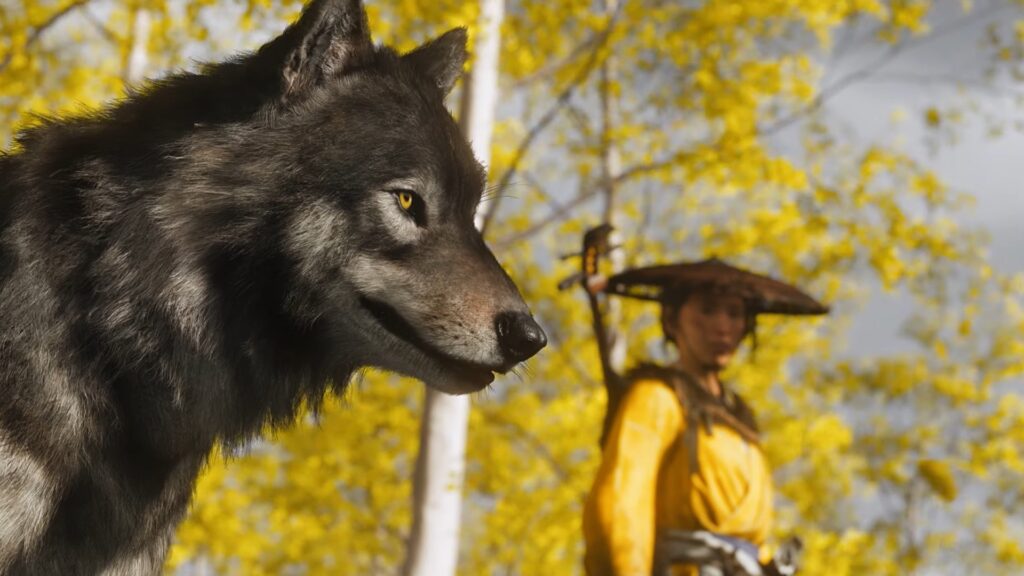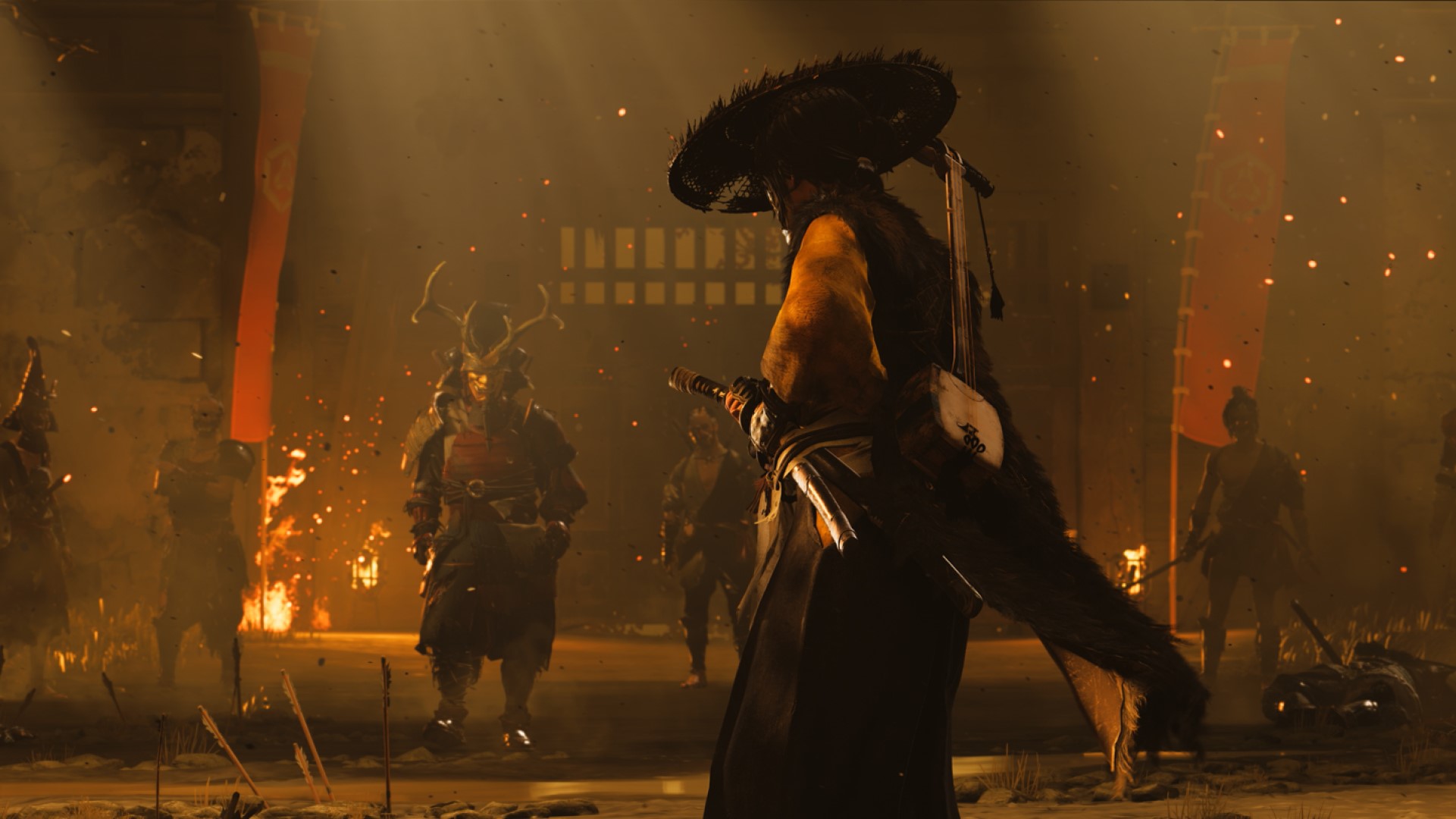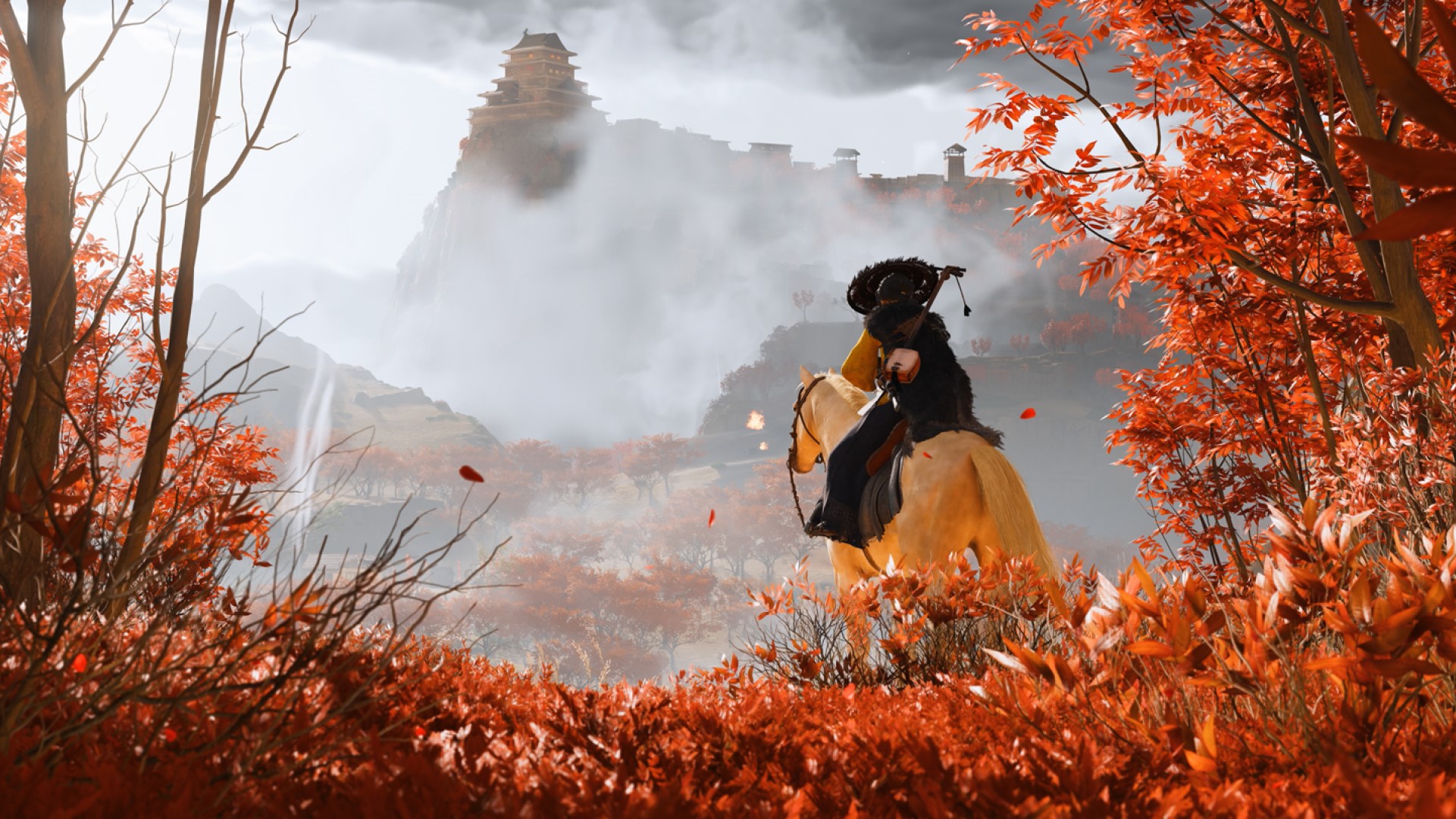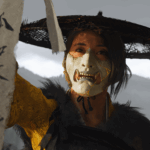Revenge is a dish best served cold, but sometimes, smoldering ashes will more than suffice. It’s not the first time Sucker Punch has dabbled in a vengeance saga – see Ghost of Tsushima – but there’s a different, more personal flavor to Ghost of Yōtei. One that’s more obsessive but introspective, and even as it seemingly works through the same moral hoops that we’ve seen before, it does so with a degree of freshness and creative ingenuity.
Which isn’t to say that you won’t be reminded of another legend, somewhere on a distant Tsushima Island, committing the same wanton acts of stealth, slash and explosive engineering. But after spending almost 40 hours in Ghost of Yōtei, intertwined in its narrative machinations and implications while taking in the sights of pre-Hokkaido Ezo, I have to say: It is an incredible experience.
Revenge Tour
“However, Ghost of Yōtei offers even more narrative layers beyond this, examining the monsters we meet as children and their power over us, real and imagined. It also talks about moving on, even if it means never confronting the thought of returning home…”
For those who haven’t seen the myriad of trailers thus far, the story revolves around Atsu, a mercenary who returns to Ezo after years, seeking revenge for her family. During her childhood, a group called the Yōtei Six slaughtered them and left her for dead, pinned to a ginkgo tree that was set ablaze. Survival shouldn’t have been possible, which fuels superstitions around this grown-up Atsu being an onryo – a yūrei who will stop at nothing for revenge.
That isn’t our first impression of Atsu during the stylish opening, which calls classic samurai flicks to mind with its cinematography and pacing. It’s one that she’s happy to reinforce, though, even while finding the onryo talk to be a little much. For years, revenge has been the only thing on her mind, driving her very way of life to the exclusion of everything else.
While my biggest initial concern was how straightforward the story could become, the best revenge fantasies are those with twists; wrinkles that alter the protagonist’s worldview beyond what’s right and wrong. However, Ghost of Yōtei offers even more narrative layers beyond this, examining the monsters we meet as children and their power over us, real and imagined. It also talks about moving on, even if it means never confronting the thought of returning home; whether there can be a life beyond simply perpetuating more violence; and if redemption is really even possible.
Of course, there’s much more surrounding the plot that I don’t want to get into because of spoilers. For every point where I predicted what Yōtei was serving up, Sucker Punch added an intriguing twist that enhanced the narrative. Beyond this, the campaign offers some great mission design, balancing large set pieces with moments of calm conversation (and though the usual practice of accompanying a character feels slightly overused, at least they match your speed).
Pack Mentality
“The fact that you can spend as much or as little time venturing through the world as you’d like, sometimes even prioritizing which Yōtei Six member to target next, is also freeing. I’m not sure how Ezo compares to the very open worlds in the genre, but it’s become one of my favorites, and easily surpasses Tsushima.”
Behind Atsu’s stoicism and survival instincts is a child-like stubbornness that often rejects the help of others (which is interesting to contrast when seamlessly switching to her childhood). Nevertheless, Sucker Punch places heavy emphasis on the Wolf Pack – characters who play an integral role in her journey, to the extent that they get a dedicated menu screen. These can range from different weapon masters who teach new skills to blacksmiths who upgrade your armor.
As such, the core cast is strong, weaving in complex motivations and emotions without hamming it up or going overboard with their performances. Even if this is a game to be experienced fully in Japanese, the English voices across the board are excellent, especially Erika Ishii, who effortlessly glides from unperturbed and cold to warm and easily annoyed as Atsu.
However, there are a few side characters that felt like they needed a bit more involvement in the story. As much as I like Ran the Bowyer, Ginji the Blacksmith and Taro the Corpse Scavenger (he has dibs on my stuff), and getting to know their innate personalities through various quests or while traipsing through Ezo, I expected something more. That being said, the handling of Atsu’s bond with the mysterious wolf is interesting – not heavy-handed but still offering narrative significance and even more layers to Atsu’s character development.
I’m sure there will be comparisons to Jin Sakai and beloved characters from Tsushima like Yuna, Masako, and, for all his flaws, Ryuzo. And while your mileage may vary in some spots, Ghost of Yōtei’s cast is distinct and well-developed, to the point where I care about what happens to them when I’m not lamenting at the lack of opportunities to get closer to some.
Where Winds Meet
Of course, the other appeal is the open world. While Tsushima Island was a gorgeous place to explore, and I enjoyed clearing enemy camps as much as following all the golden birds and foxes I could find, these elements did get a little repetitive. Ezo features these same elements alongside some new activities, including painting scenes with the touchpad, engaging in the new Zeni Hajiki coin game (which feels a little too one-sided for both players) and solving Mountain Reliquaries. Yes, you’ll be spending a not-insignificant amount of time bathing in hot springs to raise your max health and chopping rows of bamboo to increase Spirit (which replaces Focus).
But it’s incredible how Sucker Punch has taken this world and made everything feel so much more unique and varied than Tsushima. Bamboo Strikes offer a wider variety of button inputs and challenges alongside some neat little touches, like other bounty hunters cheering Atsu on (or mocking her failures). Hot springs feature interesting effects if you fulfill specific conditions. The climb to claim certain shrines is also much more involved, though not too challenging for those even mildly experienced in platformers. Even the enemy camps are more varied this time around, whether it’s different set-ups or follow-up objectives that distinguish them from the usual “clear out all enemies and take a bow.”
Yet all of that, as brilliant as it is, pales in comparison to the various quests. Maybe you discover a man whose brother has gone missing and ride out to find him while repelling attacks from hidden shinobi. You could also encounter a woman skilled in making kunai (and a mean squash stew) who asks you to check on her various farms, with details of her story unravelling over time. Then, there’s Mad Goro, a venerable legend in his own twisted ways.
There are also the usual Mythic Tales that confer unique rewards which go even further, offering sections with extensive platforming, light puzzle-solving and fun combat. Each bounty target also feels unique, sometimes interweaving with other activities in unexpected ways. Not all objectives quite hit the same, but the vast majority of side content is enjoyable more often than not.
Beyond uncovering leads pointing to the whereabouts of the Yōtei Six, you’ll receive information from random NPCs about nearby activities, adding even more fragments to your burgeoning map. The layout of the entire world is impressive – I’ve lost count of the number of times I discovered something brand new near a recently completed quest or activity. The fact that you can spend as much or as little time venturing through the world as you’d like, sometimes even prioritizing which Yōtei Six member to target next, is also freeing. I’m not sure how Ezo compares to the very open worlds in the genre, but it’s become one of my favorites, and easily surpasses Tsushima.
‘Tis but a Scratch
“The attention to detail is simply jaw-dropping, whether you’re shuffling past multitudes of leaves scattered on the ground, watching rain casually slide off of awnings or rushing through a field of flowers.”
The other major pillar, just like Tsushima, is the combat, and this is where most veterans will feel at home. Instead of the stance system, Ghost of Yōtei focuses on different weapons. You start with the katana before gaining the dual swords, the yari, the kusarigama, and the odachi, alongside the new firearms. The usual tools also apply, from smoke bombs to take enemies off guard (and make some quick assassinations) to oil for setting your weapons ablaze and dealing unblockable damage.
Depending on how you play, the combat can take some time to get rolling, since the biggest appeal is having a diverse set of weapons and tools to dispose of enemies in various ways. And since each weapon requires a few upgrades to really come into its own, it can be easy to dismiss this as a simple replacement of the stance system. However, give it time, and you’ll discover the beauty of seamlessly transitioning into a dual sword heavy weapon strike, before using the blades to effortlessly deflect yari attacks, or kicking fools off cliffs to create some space with your own yari, or long-distance assassinations with the kusarigama.
The disarm mechanic feels like a neat little risk vs. reward mechanic at first, but a little too heavily favored towards Atsu, since you can easily roll out of the way of disarming strikes without consequence. Swiftly dispatching a disarmed foe makes it worth attempting, though, and that more than counts for something. I also enjoyed the new weapon-throwing mechanic, though – there’s nothing like roaming the battlefield of fallen foes and tossing a yari, a katana, a sickle into anyone stupid enough to challenge you.
Nevertheless, I appreciate the feel of the new weapons. Even if the progression feels a little too straightforward, with some upgrades offering little more than “increased stance damage,” they synergize with the various armor sets and Charms to deliver some truly devastating combinations. Again, no spoilers, but I’m rocking three different loadouts (and praise Sucker Punch for including loadouts at launch), which I can switch to for slaying out with ranged damage, sneaking about and assassinating fools, or going toe to toe in duels, and it’s awesome.
The overall challenge also feels like a welcome upgrade over Tsushima, so much so that I had to knock the difficulty down from Lethal to Hard and eventually Medium for the sake of time. I did occasionally spot boss duels devolving into similar patterns, but the range of tactics and more complex move sets definitely made each encounter that much more memorable.
The Painted World of Ezo
Presentation-wise, Ghost of Yōtei is stunning, with the setting lending to a brighter and more varied color palette. Sucker Punch recently spoke about the increased draw, and it works wonders in portraying the sheer scale of Ezo. The attention to detail is simply jaw-dropping, whether you’re shuffling past multitudes of leaves scattered on the ground, watching rain casually slide off of awnings or rushing through a field of flowers. I played on Performance Mode, and the fact that it’s accomplishing all of this without any frame drops or noticeable pop-in (at least none that I could observe while playing) is simply mind-boggling. The music is also, unsurprisingly, downright enthralling. The shamisen is a core motif, and it’s as incredible when used in slow, moving pieces as it is in battles to convey tension.
However, there are places where the animation, especially when it comes to NPCs in casual interactions, could use some more polish. The cinematography in some dialogue exchanges also felt off at times. It’s not the biggest immersion breaker, but it stands in stark contrast to the proper cutscenes with their fidelity and excellent facial expressions. A few bugs can also disrupt the fun, such as characters not being in position for certain scenes or the odd physics that can sometimes occur on jump attacks. These are few and far between, but still worth pointing out.
Dancing With Wolves
“Atsu’s journey doesn’t rewrite the rulebook on meting out vengeance so much as establish her own journey of personal growth – and the cultural brilliance and natural beauty of Ezo…”
While Ghost of Tsushima impressed with its mix of open-world stealth and stance-focused combat, Ghost of Yōtei is both a refinement and an expansion of everything that it offered. I could see complaints about the combat being more iterative than evolutionary, but this is still an extremely impressive title worth diving into, whether you’re a fan of open-world games or not. Atsu’s journey doesn’t rewrite the rulebook on meting out vengeance so much as establish her own journey of personal growth – and the cultural brilliance and natural beauty of Ezo – and I, for one, am excited to unravel more of its mysteries and dangers.
This game was reviewed on PS5.







This sounds like a compelling exploration of revenge and its consequences. The comparison to “Sympathy for Lady Vengeance” adds an intriguing layer. I look forward to seeing how the themes unfold in your review!
I agree, the themes of revenge in both works are fascinating. It’s interesting how “Ghost of Yōtei” uses the setting to enhance the emotional weight of the story, almost becoming a character in its own right. This adds another layer to the consequences of vengeance.
I completely agree! The exploration of revenge in “Ghost of Yōtei” adds layers to the narrative that really resonate with the audience. It’s also intriguing how the setting plays a role in shaping the characters’ motivations and actions throughout the story.
Absolutely! The way the story intertwines themes of guilt and redemption really deepens the emotional impact. It makes you reflect on the true cost of vengeance and how it can affect everyone involved.